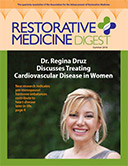In this modern age of chemical overload, liver protection is more important than ever. This critical organ is assaulted daily by environmental toxins, prescription and non-prescription drugs, alcohol, excess hormones, and synthetic food additives. As one of the largest organs in the body, the liver’s chief function is to metabolize the excessive amounts of these unwanted substances. Consequentially, liver disorders have become a major global health challenge.
Because of the enormity of this problem, a review article titled “The Treatment of Liver Disease with Botanical Agents” was published in the Journal of Restorative Medicine, Vol. 2, No. 1. The article highlights eight key botanical medicines that protect and restore the liver.
Authors Jill Stansbury, ND; Paul R. Saunders, PhD, ND, DHANP; Eugene R. Zampieron, ND; and David Winston, RH(AHG) share their combined clinical experience and herbal expertise to elucidate the use, dose, and safety features of hepatoprotective herbs. They show how these herbs offer antioxidant and anti-inflammatory actions which serve to protect the liver from damage and aid regeneration.
One of the plants identified for liver protection is Curcuma longa, a popular Indian cooking spice. Its key active constituent is the flavonoid curcumin. Among its extensive and impressive list of biochemical actions are antioxidant, anti-inflammatory, anti-carcinogenic, and hepatoprotective activities.
Practitioners find value in the clinical experiences offered by the authors, whom share herbal indications, contraindications, side effects, and dose requirements. As a clinical pearl, the authors suggest proof for the efficacy of these herbs can be demonstrated through improvement of key liver enzyme tests. Their review also identifies key biochemical constituents and activities, which are supported by extensive published research citations.
Three of the authors from this article will be featured speakers at the 14th Annual International Restorative Medicine conference, being held in Hilton Head Island, S.C., on Sept. 15-18. Jill Stansbury, ND will be presenting a three-hour intensive titled “Botanical Influences on Cell Biology, from Mechanism to Vitalism.” Eugene R. Zampieron, ND will update practitioners on herb, nutrient, and drug interactions, and review the role of herbs and nutrients for aging men. Paul Saunders, PhD, ND, DHANP will cover intravenous therapy protocols using herbs and nutrients.
Silybum marianum of the thistle tribe of the Aster family. Studies with animal models have shown Silybum and its individual flavonolignans to positively affect liver metabolism.
Curcumin is a flavonoid that has been credited with powerful antioxidant and anti-carcinogenic effects. Curcumin reduces the ability of alcohol, iron overload, biliary stasis, carbon tetrachloride, and adriamycin (doxorubicin) to damage the liver.
For free access to the article in the Journal of Restorative Medicine, visit http://restorativemedicine.org/journal/
